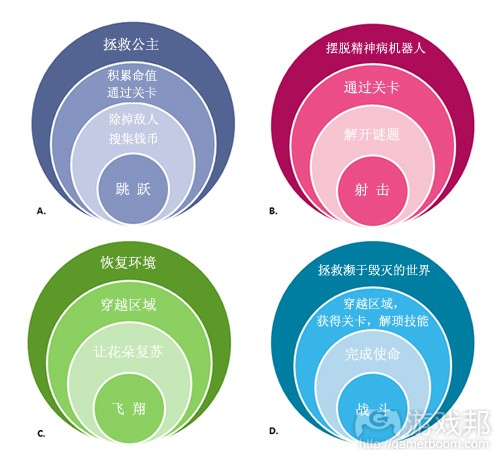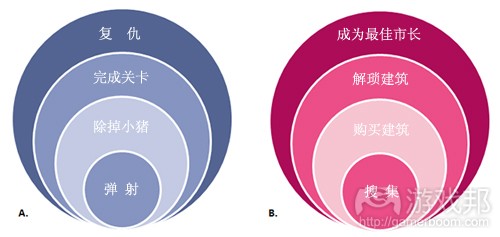以核心图表解析游戏核心机制设计原理
作者:Charmie Kim
在游戏设计领域,每个设计师都有一些自己的设计方法论,在此我想分享一些自己的心得,以助开发者理解并评估自己的设计问题。
当我还是温哥华的一名游戏设计学生时,有个导师提到了一种设计工具,我在之后的游戏设计生涯中一直使用这个强大的工具来评估自己的设计。而这个工具却是一个简单的图表,我将它称为“核心图表”:
在这个模型中,核心机制位于最中心地位,它就是游戏的核心。而其他机制则围绕这一核心层层相裹,处于最外层的就是故事层。
理论型设计师喜欢定义文字,我也不例外。我将“机制”定义为促进交互的系统,而“交互”则是玩家与游戏之间的对话。“机制”与“交互”并不足单独描述游戏本质,因为游戏是一种由这些内容相结合并作用于玩家大脑和环境而产生的体验。但在我们发明出一种能够直接将体验从一个大脑传递到另一个大脑的神经技术之前,我们设计师唯一能控制的恐怕就只是游戏机制而已。这些机制之间的关系好比是颜料和画笔,钉子和锤子。
但究竟何为“核心”游戏机制?我想最简单的理解方法就是根据它的发生频繁来判断:
*核心机制就是在游戏中最频繁发生、有意识的交互行为。例如在平台游戏中,核心机制就是跳跃;在射击游戏中,核心机制就是射击;在赛车游戏中,核心机制就是驾驶。另一个判断方法就是,若游戏缺了某个元素就无法运行,则该元素即为核心机制。
*次级机制是指发生频率较少的交互行为。它们之间甚至还可以再划分为发生频繁更高和更低的不同层次。
*进展系统组成了游戏的机制包层,它是游戏系统整体上的变化来源。
*故事层是处于最外面的层次 ,它将所有内层囊括其中。
玩法和创新
现在你已经理解了这个模型的含义,能不能据此判断出以下核心图表分别代表哪款游戏?
答案:
A:《超级马里奥》
B:《传送门》
C:《Flower》
D:奇幻类RPG
从这些例子中我们可以观察到一些现象:
*最出色的游戏通常都有一个强大而易于理解的核心机制,但也具有一定扩展空间。而假如这个机制本身就非常强大也仍然有助于游戏获得成功——这可以解释为何射击会成为一种极受欢迎的核心机制。
*最有效的游戏一般都会体现出各个层次互补的特点。你可以通过查看各个层次的相互影响来测试不同层次间的关系。例如,“为了铲除敌人,我得跳跃,而为了通过关卡获得进展,我必须铲除敌人”。如果你的游戏层次缺乏这种向外的召唤关系,以及对内的前后关系,那你可能就需要重新审视自己的设计问题了。
*真正的新鲜体验一般来自游戏核心的创新。例如,《Flower》至今仍是我最难忘的游戏体验,因为其他游戏从未像这样令我犹如置身云端飞翔。它的核心机制非常与众不同,并且极为出色。
*有时候创新也会来自不同层次间非同寻常的组合方式。例如,射击这种核心机制一般并不会与解谜元素融合在一起,但《传送门》做到了,并且将其发挥得淋漓尽致。
*有些机制可以组合成不朽的经典。例如D类游戏。这好比是经典法国菜肴,品尝起来很棒,但却很难烹制。
社交及手机游戏
我从去年开始以这个视角观察社交和手机游戏,现在再来猜猜以下两个图表是什么游戏:
A:《愤怒的小鸟》
B:《CityVille》
从中观察所得的结果如下:
*因新平台和用户而产生的最大设计变化通常来源于核心和故事层。例如在《愤怒的小鸟》中,清除小猪相当于清除《超级马里奥》中的蘑菇,并且其进程设计也基本上离不开完成或解琐机制。对我来说,有意思的现象是这里的“核心”变化多与界面或平台(游戏邦注:例如触屏界面)有关,而“故事”变化 则与游戏瞄准的玩家群体有关。
*《愤怒的小鸟》是一款设计笨拙的游戏。它将弹射与清除小猪联系起来,但并非一种直接关第,有时候甚至让人感觉有点牵强。而将弹射与完成关卡联系起来就更怪了。你是否曾在玩这款游戏时也有这种奇怪之感,即你错过一只小猪后却还是要不停地反复尝试要击中它?这种感觉令人尴尬,并且一点都不有趣。上述图表中没有纳入的元素就是积分系统,因为它和其他层次的融合度并不高。清除小猪可以让你获得分数,但你玩游戏就是要清除小猪,所以这个系统就显得有点多余,而要完成关卡却需要积分,这种设置就显得极具强迫性了。对于《愤怒的小鸟》为何如此强大,相信每个游戏设计师都有自己的见解,但我认为这个图表已能够证明这款游戏设计很不妥。
*我并没有针对所有的Zynga游戏制作核心图表,但我认为几乎每款Zynga游戏的虚拟世界(除了以Indiana Jones为主题的那款游戏,以及寻物解谜游戏之外)都有三个相同的内层——搜集/收割,买东西,解琐内容。看起来Zynga成员似乎知道这三个内层的妙处,并且希望一直挖掘同样的设计。
我还没有研究这种模型为何会适用于社交/多人游戏,而这也并非本文要探讨的话题。但我认为真正的社交游戏的各个层面至少都需要至少2名玩家参与互动。假如要我把Zynga游戏设计得更有社交性,我可能会将搜集设置为与好友一起参与的活动(Zynga游戏已经实现这一点),将购买建筑的行为也同好友相绑定(例如,我买了个服装设计工作室,那么好友就买一个时装精品店,我可以向好友的店面提供服装,我们可以一起进行利润分成)。为何《魔兽世界》这种MMO游戏会如此强大?因为他们采用了典型的RPG模式,并且在每个步骤中都巧用了社交动态元素。
策略游戏
我发现在其他游戏的核心机制中,优秀的平台游戏设计师可能会将注意力集中于音个跳跃物理机制中,这样即使没有次级机制或进展元素,这个核心活动也仍会富有生气。但并非每个核心机制都需要拥有如此紧凑的单个循环。例如在策略游戏的核心机制通常是“单位布局”。严格来讲,在策略游戏中移动物体并没有什么天然乐趣,但如果将其视为一项大脑活动,就会理解其核心机制究竟有何意义和深度,策略游戏为何如此好玩。要知道策略游戏中的核心机制一般也更复杂,并融入了多种不同的反馈循环。换句话说,这种游戏的核心交互过程需要处理更多信息。
模式转换
在此我得先声明:并非所有游戏都适合我采用的这个模型,有许多成功游戏可能会进行模式转换,即从一个核心图表转变为另一个图表。我认为这种方式也会非常有效,假如一个机制更紧凑,而另一个机制更轻松,那么这种模式转换就可以发挥协调作用。这方面的典型例子就是《质量效应》。
希望这个工具能够对你有所启发,因为它对我来说真的很有帮助。你也可以试着为自己最喜欢的游戏绘制出核心图表,从中分析出有价值的参考信息。(本文为游戏邦/gamerboom.com编译,拒绝任何不保留版权的转载,如需转载请联系:游戏邦)
Designing around a core mechanic
by Charmie Kim
It’s easy to plug game mechanics into your game design, but it’s not always obvious whether those mechanics suit your game. Here’s a simple framework to help you understand and evaluate your design from the core out.
Reposted from Funstormgames.com blog.
In our wild wild game design world every designer is likely to have their own shade of design methodology, lack thereof being a kind of methodology of its own. I’d like to share a bit of mine.
When I was still a game design student in Vancouver, I was taught this life-changing design tool by a mentor (giving credit where it’s due!) over lunch at a White Spot. At least one mind was blown in that generic family-style restaurant that day. I’ve been whipping this tool out to evaluate every bit of game design I do ever since. Trust me, it’s amazing.
The tool is a deceptively simple diagram that I call the ‘Core Diagram’:
In this model, the core mechanic is at the very center and forms a nucleus for your game. The other mechanics form layers around the core, with the narrative forming the very outer layer.
Theory-crafting game designers love to define words, as do I, so let’s not skip that bit! By mechanic I mean a system that facilitates interaction, and by interaction I mean a kind of conversation between the player and the game. Neither of these words actually amount to what games actually are, because a game is the experience generated by those words when they get put in a disco with the player’s brain and circumstance. However, until we invent neuro-technology that can transfer experiences directly from one brain to another, what us game designers can control within this dance are the mechanics. The mechanics are the paint and paintbrush, the nail and hammer, the two girls and cup of our art!
But still, it’s probably not very clear what exactly is a ‘Core’ mechanic in a game. Easiest way to understand it, I think, is in relation to time.
•The core mechanic in a game will usually be the purposeful interaction that occurs the most frequently. In a platforming game, this is usually jumping. In a shooter, it is usually shooting. In a racing game, it will be driving. Another way to determine the core mechanic is, if without it, you wouldn’t be able to play the game at all.
•The secondary mechanics are the interactions that happen less frequently. They could even be layered out from more frequent to least frequent.
•Progression systems form the mechanical envelope of the game, being the source of change within the game system at a holistic level.
•The Narrative layer is the outer most layer that puts all the inner layers within it into context.
Gameplay and Innovation
Now that you understand the model, could you guess which games each of these core diagrams represent?
The answers are:
A. Super Mario Bros.
B. Portal
C. Flower
D. Every fantasy RPG ever made
There are some qualitative observations that can be made immediately, just from looking at these examples.
•The best games usually have a very strong core mechanic that is easy to grasp but provides room to expand upon. It also helps if the mechanic has a powerful meaning to it of its own – there’s a good reason why shooting is such a popular core mechanic in our field.
•The most effective games are ones where each layer compliments the other. You can test the relationship between the layers by seeing what effect each layer has on the other. i.e. “In order to remove enemies, I must jump, and in order to progress through levels, I must remove enemies.” If your layers don’t have this kind of gating relationship going outward, and contextual relationship going inward, you may want to re-consider your design!
•Truly fresh experiences often result from innovations at the core of the game. For example, Flower is to this day one of my most memorable game experiences because I’d never played a game that made me feel so much like I was flying in the wind. It had an unusual core mechanic, and it did that mechanic extremely well.
•Sometimes innovation comes from having an unusual combination of layers, for example, the shooting core mechanic won’t normally be paired with solving puzzles. But Portal did it, and did it well.
Also consider how Portal differs from shooter games that have puzzles on the side (puzzles that do not use the shooting mechanic in order to solve them), and how effective those experiences are in comparison.
•Some combinations of mechanics are truly timeless, such as D. It’s like a classic dish in French cuisine – it tastes good, and it’s hard to mess with.
Social and Mobile
In the last year or so I started looking at social and mobile games in this light, and again, it’s really fascinating to see how they map.
Let’s play guess the game again! Ready?
A. Angry Birds
B. CityVille
Now some more observations!
•The biggest shift in design caused by new platforms and audiences are in the Core and the Narrative layers. Removing pigs is no different from removing mushrooms, and completion or unlocking mechanics have always been staples in progression design. This is really interesting to me because I understand it to mean that the Core shifts mostly with new interfaces or platforms, like the touch screen, while Narratives shift because of the different players that the games target. But otherwise, game design is still game design!
•Angry Birds is an awkwardly designed game. Flinging relates to removing pigs, but the relationship is indirect, and sometimes feels arbitrary, even. This also makes relating flinging to completing levels rather awkward. You know that strange feeling you get in an Angry Birds level where you have that one pig off to the side that you can’t seem to get, and you’re madly playing fling trial-and-error to get it? Yea, it gets a little awkward, and not fun! Something else that gets left out in this diagram is the points system, it just doesn’t fit very well with the other layers. Removing pigs gets you points but you have to remove them anyway so it’s redundant, and the points are needed to complete the levels but in an entirely arbitrary way! Every game designer in the world has their own opinion on how Angry Birds got to be so big, but I think I have proof here that it ain’t the design.
•In comparison, CityVille is amazingly elegant within the inner 3 layers. Look how tightly collecting currency weaves into buying buildings, and collecting XP weaves into unlocking buildings, which weaves back into buying buildings, and then again, weaves back into collecting from them. Beautiful! But, there is still a weakness, and it’s a big one. Exactly how does clicking buildings to collect from them (it’s not even made very clear that they are supposed to be taxes) and unlocking buildings (again, messaged in a very ‘game-y’ way with buildings unlocking at every level) make you a better mayor? CityVille could do well with some tweaks in how it integrates its overall narrative.
•I don’t have a diagram here for all the Zynga games but my biggest beef with them is that almost every one of their virtual world games (other than their newer Indiana Jones game and the hidden object game) have the same 3 inner layers – collect/harvest, buy stuff, unlock stuff. It’s like they know how good it is and they wanted to explore that same design until noone wanted to play it anymore.
I haven’t tackled how social/multiplayer fits into all this, that would be a post of its own. But a good measure to go by is, a truly social game would require more than one player involved at each of the layers. If I were to make a Zynga game more social, for example, I would make collecting an activity done with friends (this is already the case), buying buildings would be in relation to friends (for example, if I buy the Fashion Design Studio building and you buy the Clothing Boutique building, I could supply you with clothes for your building and we could split profits, right?) etc. Is it any wonder MMO games like WoW are so powerful? They take the classic RPG formula and apply social dynamics every step of the way.
Strategy Games a.k.a. The Slow Core
The core mechanics I’ve looked at in other games so far have a physical ‘fun’ to it on its own. A good designer working on a platformer would pay a lot of attention to the physics of a single jump so that the core activity feels good even without the secondary mechanics or progression. Yet, it would be a mistake to think that every core mechanic needs to have such a twitchy tight singular loop. Looking at strategic games, for example, the core mechanic is often ‘unit placement’. Physically speaking, there’s nothing innately joyful about placing a unit in a strategy game, but look at it as a cerebral activity and it sheds light on how deep and meaningful this core mechanic can be and why strategy games are so much fun. Note also that with strategy games, the core mechanic is far more complex and involves lots of different feedback loops within it. In other words, there’s a lot more information being processed within the interaction right in the core!
Modal Shifts
I would also add a caveat here and say that not all games fit this mould so well, and those are some of the most fun. Many successful games do modal shifts where you go from one core diagram to another. This works really well, I think, if one set of mechanics is more twitch and the other more relaxed, and the modal shift is used for pacing. A great example of this is one of my favourite game franchises of all time, Mass Effect!
I hope this tool is as inspiring for you as it has been for me, at the very least I hope you find the musings interesting. Try mapping some of your favourite games and see what the diagram can teach you through them. Are there any games that really don’t map at all? Let me know!(source:gamasutra)










































 闽公网安备35020302001549号
闽公网安备35020302001549号